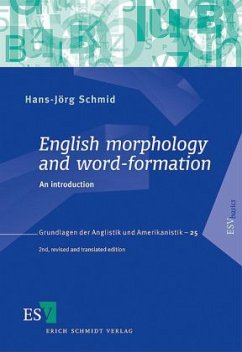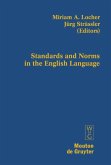Serving as a basic introduction to the field of English morphology and word-formation, this book also tries to advance the state-of-the-art in this field in a number of respects. The author takes his readers gently through the basic notions in English morphology and word-formation and discusses problematic areas and definitorial questions. All chapters are approached systematically from three different angles focusing on structural, cognitive and sociopragmatic aspects of the field. In this way, new perspectives are opened particularly on the development and establishment of new complex words, on the cognitive functions of word-formation patterns and on the field of conversion. Students of English and linguistics will be able to use this book not only as an introduction but also for preparing exams, term papers and final theses. The large number of examples are taken from a corpus of authentic language, which also serves as a basis for frequency counts of morphological features and elements in different text-types.
Das Buch führt schrittweise in die Grundbegriffe der englischen Morphologie und Wortbildung ein und fasst den aktuellen Forschungsstand gut verständlich zusammen. Besonderes Augenmerk wird dabei auf eine präzise Ausdifferenzierung der Begriffe gelegt, um ein Bewusstsein für terminologische Grauzonen und Übergangsphänomene zu schaffen. Neue Sichtweisen zu einer Reihe von Themen, u. a. zum Verlauf der Etablierung neuer komplexer Lexeme, zu den kognitiven Funktionen der verschiedenen Wortbildungsmuster und zur Konversion, runden die umfassende Darstellung ab.Studierenden der Anglistik und Linguistik kann das Buch neben der Einführung in die Materie somit auch zur Vorbereitung auf Prüfungen, als Hilfsmittel für Seminar- und Abschlussarbeiten sowie dank seines umfangreichen Sach- und Morphemregisters auch als Referenzwerk dienen. Praxisbezug und Aktualität werden durch den Einsatz von authentischem Korpusmaterial gewährleistet, das nicht nur laufend zur Illustration dient, sondern auch für Angaben über die Vorkommenshäufigkeit morphologischer Phänomene in verschiedenen Textsorten ausgewertet wird. Diesermöglicht eine Erweiterung der in der Morphologie traditionell dominierenden strukturellen Perspektive in Richtung moderner soziopragmatischer und kognitiv-linguistischer Ansätze.
Das Buch führt schrittweise in die Grundbegriffe der englischen Morphologie und Wortbildung ein und fasst den aktuellen Forschungsstand gut verständlich zusammen. Besonderes Augenmerk wird dabei auf eine präzise Ausdifferenzierung der Begriffe gelegt, um ein Bewusstsein für terminologische Grauzonen und Übergangsphänomene zu schaffen. Neue Sichtweisen zu einer Reihe von Themen, u. a. zum Verlauf der Etablierung neuer komplexer Lexeme, zu den kognitiven Funktionen der verschiedenen Wortbildungsmuster und zur Konversion, runden die umfassende Darstellung ab.Studierenden der Anglistik und Linguistik kann das Buch neben der Einführung in die Materie somit auch zur Vorbereitung auf Prüfungen, als Hilfsmittel für Seminar- und Abschlussarbeiten sowie dank seines umfangreichen Sach- und Morphemregisters auch als Referenzwerk dienen. Praxisbezug und Aktualität werden durch den Einsatz von authentischem Korpusmaterial gewährleistet, das nicht nur laufend zur Illustration dient, sondern auch für Angaben über die Vorkommenshäufigkeit morphologischer Phänomene in verschiedenen Textsorten ausgewertet wird. Diesermöglicht eine Erweiterung der in der Morphologie traditionell dominierenden strukturellen Perspektive in Richtung moderner soziopragmatischer und kognitiv-linguistischer Ansätze.




